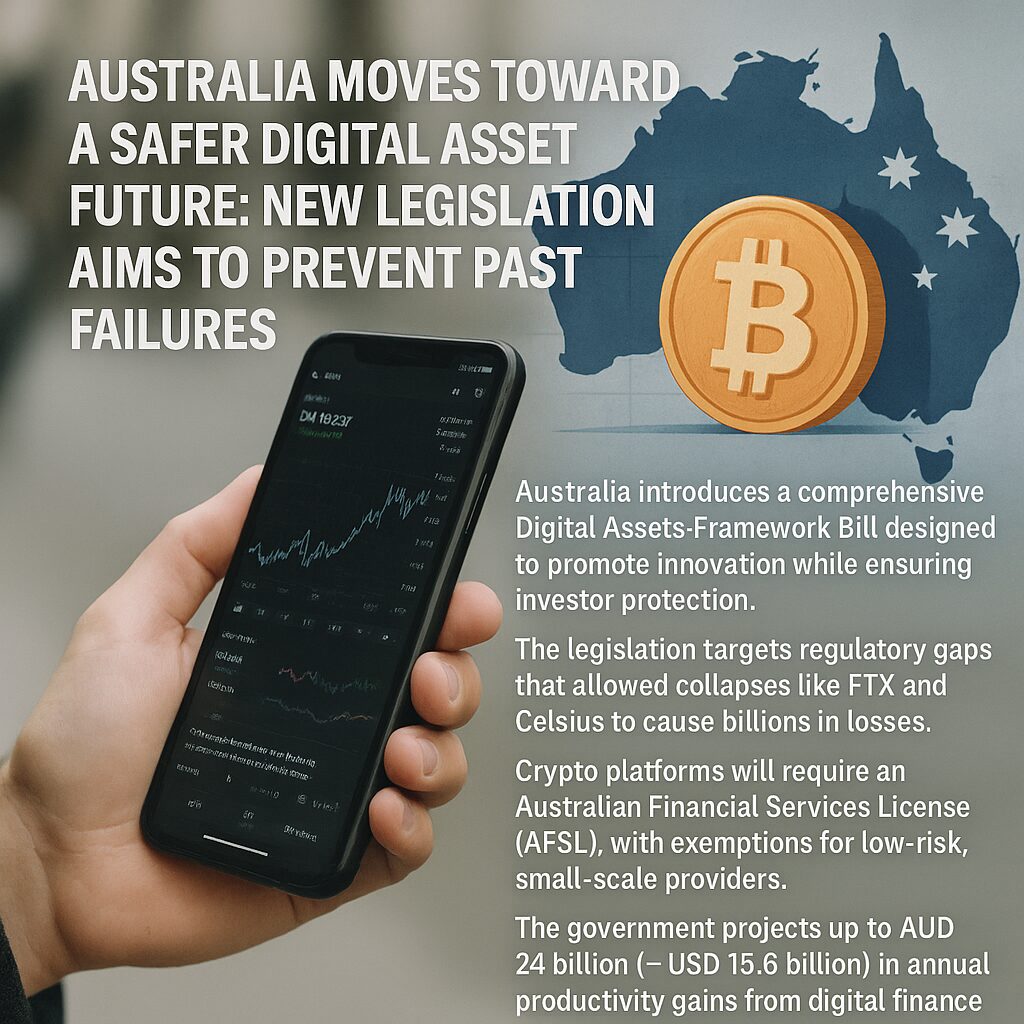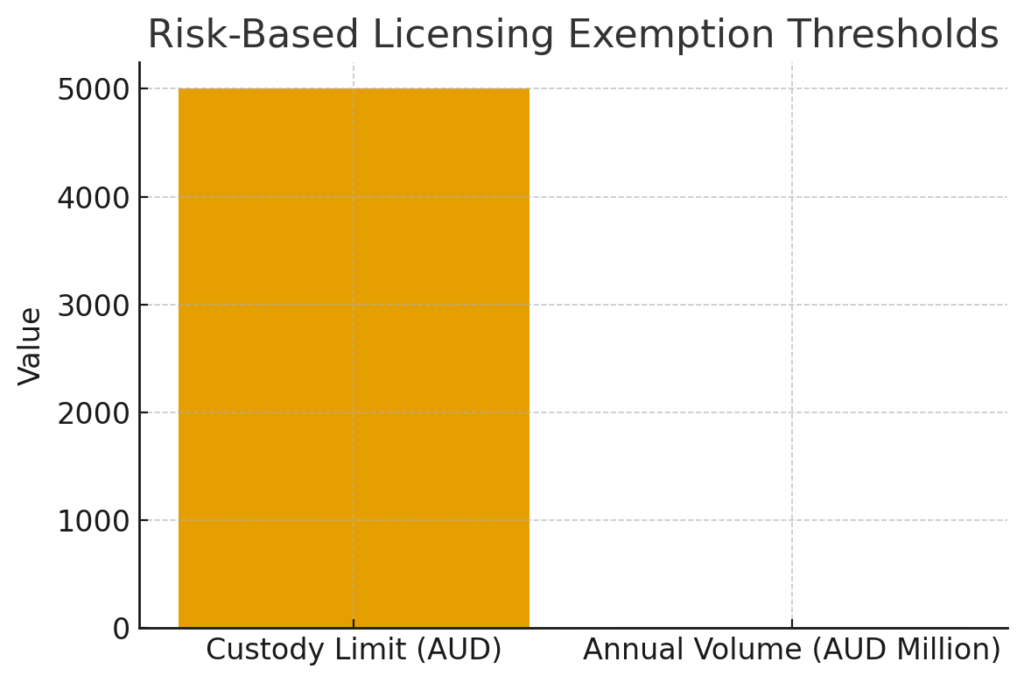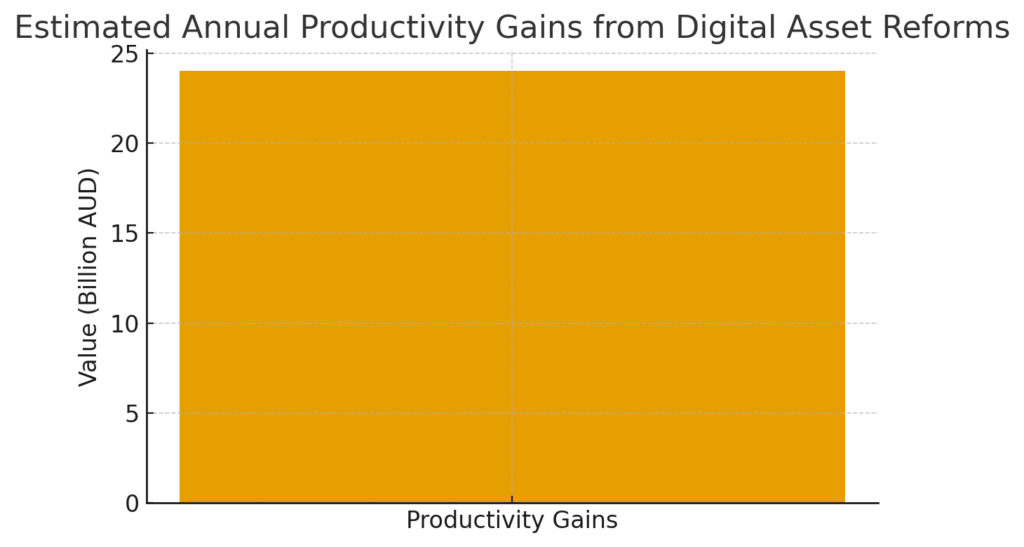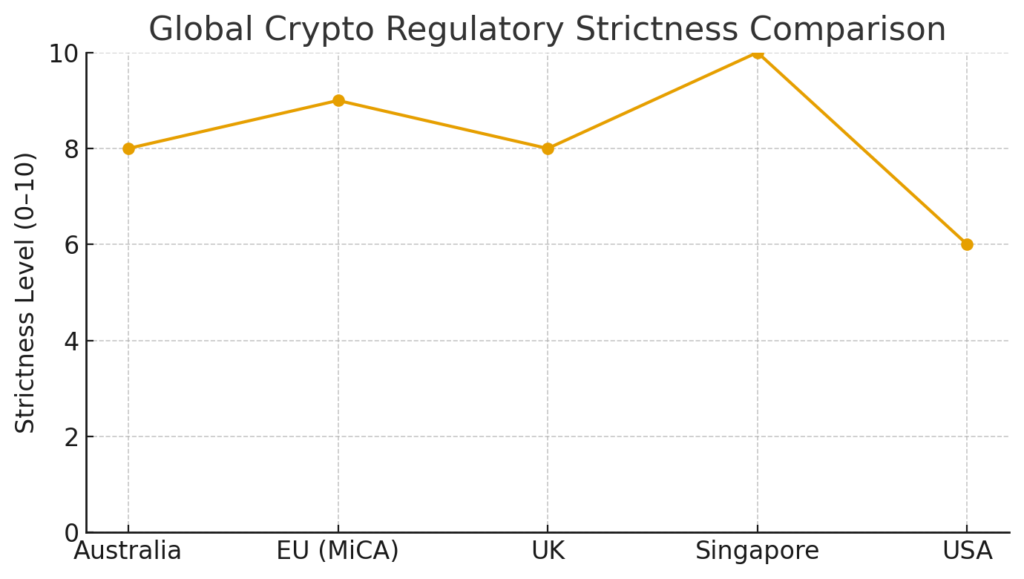
Main Points :
- Australia introduces a comprehensive Digital Assets Framework Bill designed to promote innovation while ensuring investor protection.
- The legislation targets regulatory gaps that allowed collapses like FTX and Celsius to cause billions in losses.
- Crypto platforms will require an Australian Financial Services License (AFSL), with exemptions for low-risk, small-scale providers.
- The government projects up to AUD 24 billion (≈ USD 15.6 billion) in annual productivity gains from digital finance innovation.
- The bill aligns Australia with stricter global trends (US, UK, EU MiCA) and positions the country as a competitive Web3 hub.
Introduction: Australia Enters a New Phase of Digital Asset Governance
Australia has introduced a landmark Digital Assets Framework Bill aimed at reshaping how cryptocurrencies and blockchain-based services are regulated within the country. The bill—officially titled the 2025 Corporations Amendment (Digital Assets Framework) Bill—was submitted to Parliament on November 27 with the dual goals of encouraging innovation and ensuring strong investor protection.
The proposal arrives after years of regulatory ambiguity surrounding crypto custody, exchanges, and digital asset-related financial services—a gap that famously allowed the collapse of offshore platforms such as FTX and Celsius to wipe out billions of dollars in user funds. For Australian consumers, many of whom lost access to legal remedies, the collapse exposed a critical need: a strong, enforceable, and transparent regulatory framework.
In response, the new legislation seeks to embed all crypto-related financial activities into the broader financial system under rules that mirror existing standards for traditional financial services. The Australian Ministry of Financial Services stated that companies holding digital assets on behalf of consumers will now be required to comply with “clear, enforceable rules designed to protect customers and promote a stable market environment.”
Section 1: Why This Law Matters — Fixing the Gaps Exposed by FTX and Celsius
The collapse of FTX and Celsius revealed widespread structural weaknesses across global cryptocurrency markets:
- Lack of proper custody regulation
- Poor segregation of customer assets
- Insolvent business models disguised by opaque operations
- Absence of enforceable consumer protections
- Offshore entities operating without accountability
Australia was disproportionately affected. Thousands of Australian users lost access to their funds, and billions of dollars in assets evaporated. Because these companies operated offshore, Australian courts and regulators had limited ability to intervene.
The new Digital Asset Framework aims to ensure this never happens again. Under the proposed system, all crypto custody businesses and trading platforms serving Australian customers must operate under the oversight of the country’s existing financial regulatory regime. This includes:
- Capital adequacy requirements
- Segregation of customer assets
- Transparent reporting rules
- Fit-and-proper criteria for management
- Independent audits
By embedding crypto oversight into the existing financial infrastructure, Australia effectively eliminates the “regulation-free zone” that allowed past failures to grow unchecked.
Section 2: Core Requirements — AFSL Licensing and Risk-Based Obligations
Mandatory AFSL Requirement
Under the proposed law, any business that:
- Holds digital assets on behalf of customers, or
- Provides exchange or trading services
must obtain an Australian Financial Services License (AFSL).
The AFSL requirement aligns crypto businesses with existing rules for non-cash payment services, online brokerages, and custodial service providers. This effectively puts crypto companies under the same operational standards as established financial institutions.
A Risk-Based Regulatory Framework
One of the most notable features of the bill is its risk-adjusted obligations. Platforms will not be regulated with a one-size-fits-all approach. Instead, requirements scale based on the platform’s structure, volume, and consumer-asset exposure.
Small-Scale, Low-Risk Exemption
Crypto platforms may be exempt from licensing if they meet both of the following thresholds:

- Customer holdings below USD 3,300 equivalent per person
- Annual trading volume below USD 6.5 million equivalent
This exemption is designed to protect small startups, incubators, and low-risk Web3 applications, ensuring Australia continues to foster innovation while maintaining strong guardrails for consumer-facing businesses.
Section 3: Expected Economic Impact — Up to AUD 24 Billion in Annual Gains
The government projects that removing inefficiencies in digital finance could unlock up to AUD 24 billion (≈ USD 15.6 billion) in productivity improvements every year.
These gains come from:
- Reduced settlement and transaction costs
- Lower compliance costs due to standardized frameworks
- Faster digital onboarding and identity verification
- Streamlined cross-border payments
- Increased trust from institutional investors
Australia expects these benefits to fuel domestic innovation in digital payments, tokenized assets, blockchain infrastructure, and capital markets modernization.

Section 4: Global Context — Australia Joins the Wave of Crypto Regulation
Around the world, major economies are rapidly moving to regulate digital assets:
- United States: SEC and CFTC enforcement actions, stablecoin bills under consideration
- European Union: MiCA (Markets in Crypto-Assets) implemented in stages
- United Kingdom: FCA oversight for crypto promotions and exchange operations
- Singapore: Stringent licensing under the Payment Services Act
Australia’s bill shares features with the UK’s FCA risk-based approach and the EU’s MiCA consumer-protection emphasis. This positions Australia to remain competitive as a Web3 hub while ensuring high compliance standards for domestic and foreign businesses.

Section 5: What This Means for Crypto Investors and Builders
For Investors
- Better protection of funds
- More transparent and compliant exchanges
- Lower risk of catastrophic losses
- A safer environment for newcomers to participate in digital assets
For Startups and Developers
- Clear rules for launching products
- Validation for institutional investors
- A friendlier environment for fundraising
- Access to licensed infrastructure, enabling trust and growth
For Large Institutions
- Regulatory clarity
- Lower operational risk
- Faster path to product rollout
- Opportunity to build tokenization, custody, and trading systems aligned with global rules
Australia’s regulatory certainty gives it a significant advantage over countries where laws remain unclear or inconsistent.
Section 6: New Opportunities — Tokenized Assets, Web3 Payments, Stablecoins
The Australian government’s economic modeling shows particular growth potential in:
1. Tokenized Financial Instruments
Bond markets, equities, and real-estate tokens can be issued faster, with reduced settlement cycles and clearer compliance structures.
2. Web3 Payment Rails
Digital wallets, merchant payment systems, and B2B remittance tools stand to gain from the bill’s regulated infrastructure.
3. Institutional Stablecoin Adoption
Banks and fintechs can now issue AUD-backed stablecoins with greater clarity, unlocking enterprise-grade digital finance applications.
4. Digital Asset Custody for Enterprise Clients
With clearer standards, enterprises can outsource custody to licensed providers.
Conclusion: A Stronger, Safer, More Innovative Digital Asset Future
Australia’s Digital Assets Framework Bill represents one of the most comprehensive crypto regulatory reforms among developed economies. By balancing strict consumer protection with a flexible, innovation-friendly structure, the country is positioning itself as a global leader in digital finance.
The legislation directly addresses the failures that caused massive losses in previous cycles, builds trust in the market, and lays the foundation for Australia’s Web3 ecosystem to thrive. Whether viewed from the perspective of investors, developers, or large institutions, the new framework opens meaningful opportunities for growth while ensuring that the mistakes of FTX, Celsius, and similar cases are not repeated.
As Australia integrates digital assets into its regulated financial system, it sends a clear message: innovation is welcome, but responsibility and transparency are mandatory.

